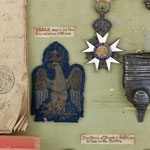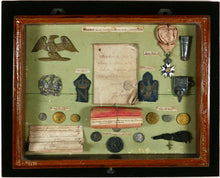Napoleonic Relics from the Field of Waterloo, 1815
Adding product to your cart
Overall: 32cm (12.5in) x 40cm (15.75in)
Comprising a collection of battlefield relics contained in glazed drawer labelled in a nineteenth century hand ‘Trophy’s found in the Field after the Battle of Waterloo’, comprising a First Empire Legion d’Honneur (2nd type) Chevalier’s breast badge, (56mm x 37mm), in silver, gold and enamel, unmarked, with ribbon and rosette, one section of wreath missing, the enamel damaged, labelled ‘Cross & Riband of the Legion of Honour’; a length of and faded Grand Cross sash ribbon, labelled, ‘The Cordon of the Legeon (sic) of Honor worn by a French General Officer in the Battle’; other ranks’ cartridge box plate in brass; silver crowned eagle badge from the gorget of an officer of the Imperial Guard, two bullion embroidered officers’ turnback badges on cloth backing - one a crowned eagle, the other a crowned letter ‘N’, with labels ‘Worn on the breast of an Officer’; top and bottom silver sword chapes; buttons (6), all different, labelled, ‘Buttons of French Soldiers killed in the Battle’; small keepsake badge in the form of an ascending dove; French coins (4) - all pierced, labelled, ‘Money found with some of the dead’; manuscript soldiers instructions booklet, in French’; a handwritten list, in French, additionally inscribed, ‘taken off the field at Waterloo 26 June 1815’.
It is almost certain the present relics were purchased from the museum created by Sergeant-Major Edward Cotton (1792-1849), a Waterloo veteran and authority on the epic battle. Cotton was born on the Isle of Wight and enlisted in the 7th Hussars in London in 1813. He saw active service in the Peninsula War, being present at the Battles of Orthes and Toulouse in 1814. At Waterloo he was stationed with the 7th Hussars on the right of Wellington’s line, a position which ensured they were heavily involved in the counter-charges against the massed French cavalry attacks in the late afternoon of the conflict. In an act of heroism, Cotton saved the life of a fellow Hussar Edward Gilmore as he lay trapped under his wounded horse in front of the main battle line. Cotton could see the French cuirassiers advancing and, knowing that they spared none who fell into their hands, sprang from his horse, rushed to extricate Gilmore and carried him to safety.
Cotton was discharged from the Army with a good service record in February 1828, being unfit for further service, and becoming a Chelsea Out-Pensioner. Described as a ‘clever and well educated man’, he settled at Mont St. Jean village on the Waterloo battlefield and soon established a reputation as a fine battlefield guide for the steady stream of tourists. He also built up a formidable knowledge of the battle from the many fellow Waterloo veterans who visited the site and published their recollections in 'A Voice from Waterloo'. His extensive collection of relics and memorabilia occupied a building at the base of the Lion Mound and became a must-see destination, with a pair of Napoleon’s silver spurs as one of its prized exhibits. The museum continued to be run after Cotton’s death until by his great-niece until its final dispersal in 1875.








